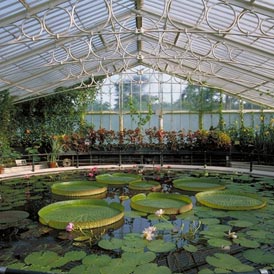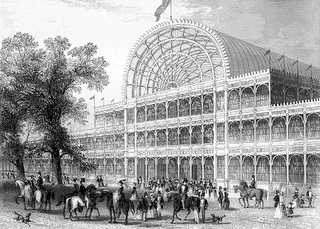This is the Amazonian Water Lily, Victoria amazonica. It is the classic, iconic water lilly of fairy tales and stories. These huge aquatic plants are native to South America. They were first discovered in Bolivia in 1801 and named in honour of Queen Victoria.
When European botanists first experimented with seeds of the Victoriana water lily, they had no success. By 1846, the Royal Botanic Garden in Kew successfully germinated seeds that had been stored in a jar of wet clay, but the plants would not mature. In 1849, seeds were sent from South America to the Duke of Devonshire's gardens at Chatsworth in Derbyshire. These seeds germinated, matured, and produced a flower. Appropriately enough, the first flower that bloomed at Chatsworth was presented to Queen Victoria.
The head of Chatsworth gardens was Sir Joseph Paxton, a noted landscape architect. He also liked to design glasshouses.
Having studied the Victoriana water lily at Chatsworth, he built a conservatory and a water lily house, taking the design for both structures from the intricate, veined pattern of the underside of the Victoriana leaf. These conservatories, proved to be the basis for the structural design of the Crystal Palace, designed by Paxton and built in London in 1851 for the Great Exhibition. Thus, the origin for the design of the Crystal Palace, a triumph of 19th century architecture and technology, was rooted in the leaf of this amazing Amazonian water lily.
The enormous leaves, which grow to over 2.5m across, have a network of protruding ribs on the underside, which give the leaf buoyancy and stability. A mature leaf can support over 50 kgs.
The flowers are large, 45cms across and fragrant, but short-lived, lasting only 48 hours. As each flower matures, it changes colour from white, through pink, to purplish-red, finally sinking below the surface.

The Amazonian water lily imprisons its pollinators. The pure white flowers open in the evening and releases a fragrance similiar to pineapples. Beetles and Sphinx moths are attracted by the smell, finding their way to the pale flowers on the dark water. At night, the flower closes over the pollinators. When the flower is closed, the anthers ripen and release pollen over the trapped beetles and moths.
By the second evening, the flowers have turned pink inside and have lost their fragrance. They open, releasing pollen covered insects, which fly off in search of more flowers. These lilies do not self-pollinate as they are only able to be pollinated when the flower is white and fragrant. The flowers then wither and die.
The seedpods are the size of a baby’s head and sink beneath the water once developed. These plants can only reproduce by seed, which can lay dormant in mud for up to 4 years before germinating. The plant has an annual dormancy period before producing more leaves that progressively increase in size before flowering again.
Victoria amazonica is absolutely spectacular in every sense.But there are more big, South American plants to come . . .





2 comments:
"These plants can only reproduce by seed, which can lay dormant in mud for up to 4 years before germinating." How cool! Thanks for sharing its story--I'm enjoying your blog.
I can not make my brain comprehend that those huge lilies actually exist...outstanding! They absolutely do not look real...amazing.
:) xo
Post a Comment